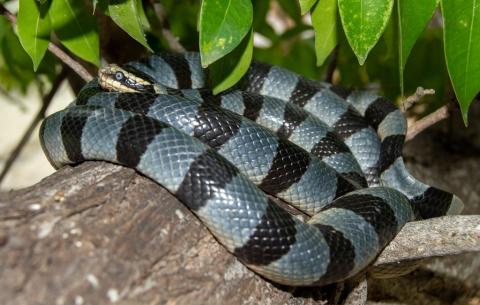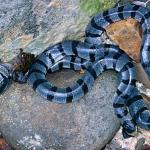- Home
- Herpetofauna Index
- Native
- Laticauda Colubrina
Laticauda colubrina
Yellow-lipped sea krait
Laticauda colubrina
(Schneider, 1799)

Length: Females can reach lengths of up to 1.7m; males are significantly smaller rarely exceeding 1.0m.
Weight: In adults between 0.4 and 1.2kg, with the males being lighter than the females.
Description
The second-most encountered marine snake in Aotearoa. As with the much more frequently encountered yellow-bellied sea snake (Hydrophis platurus), they are often sick/beach-wrecked when found, and being highly venomous should be reported to DOC so that appropriate actions can be taken for both human and the animal's safety.
This striking species is known for its beautiful steel blue, and black banding running along the entirety of its body, which fades into pale yellow on the undersides and on the facial mask.
They are visually similar to the brown-lipped sea krait, but can be distinguished by the presence of a yellow upper lip as opposed to the brown upper lip of the aforementioned species. Can be differentiated from the New Caledonian sea krait based on colouration (blue vs. grey to brown), and from the yellow-bellied sea snake by general morphology (blunt vs. flattened elongate head) and patterning (banded vs. striped).
Life Expectancy
Not known.
Distribution
The yellow-lipped sea krait has the widest distribution of any Laticauda species, occurring throughout the Indo-Pacific region from the eastern coast of India through to the islands of the western Pacific (as far as Tonga).
A rare visitor to New Zealand, this species is most commonly seen around the northern North Island, with a few records as far south as the Wellington region.
Ecology and Habitat
A semi-aquatic species which spends up to 50% of its time on land (including the intertidal zone) when mature. They are often associated with the shallow waters surrounding islands, coral reefs, and mangroves where they can be seen hunting for prey at night. However, they have been reported as diving to depths of up to 60 metres when hunting in deeper waters. When on land they typically shift between basking sites and refugia (rock crevices, complex tree root structures, tree cavities, and various ground debris), and are known to be good climbers. Females tend to spend more time on land than males, although this is likely associated with reproductive factors.
The homing behaviour of the yellow-lipped sea krait is extremely strong, and as such animals displaced several kilometres can adequately return to their native home range. As such many island populations are essentially separate, with little intermingling of the larger metapopulation.
Social Structure
This species is typically solitary, although they can be found in large aggregations on land (5-15 individuals), especially during the breeding season when several males can often be found courting lone females.
Breeding Biology
Yellow-lipped sea kraits do not breed in New Zealand.
They are oviparous (egg-laying), with females depositing between 4-20 eggs into sheltered crevices on land, either seasonally (e.g., Fiji) or aseasonally (e.g., Philippines). Sexual maturity is reached at 1 ½-2 ½ years old.
Diet
Primarily an eel specialist, although they are known to prey upon other small fish species. There is some sexual dimorphism regarding dietary habits with the larger females primarily preying upon conger eels (Conger spp.), and the smaller males on moray eels (Gymnothorax spp.).
Disease
The yellow-lipped sea krait hosts several reptilian diseases and parasites including the sea snake tick (Amblyomma nitidum).
Conservation status
Listed as a vagrant (species outside its normal range) in the most recent threat classification for New Zealand reptiles, and as Least Concern under the IUCN criteria.
Interesting notes
Although highly venomous, they are non-aggressive, and thus it is extremely rare for envenomation to occur. Bites only occur when the animal is accidentally grabbed, and the animal bites in self-defence, as is the case when the animal is being removed from fishing nets.
It is possible that on occasion several of the sea krait species arrive in New Zealand on board private boats, as the animals have a tendency to climb into small spaces such as water intakes and exhaust pipes.
References
van Winkel, D., Baling, M., & Hitchmough, R. (2018). Reptiles and Amphibians of New Zealand: A Field Guide. Auckland University Press, pp376.

A Yellow-lipped sea krait resting on a beach (Leleuvia Island, Fiji). © Tom Vierus






